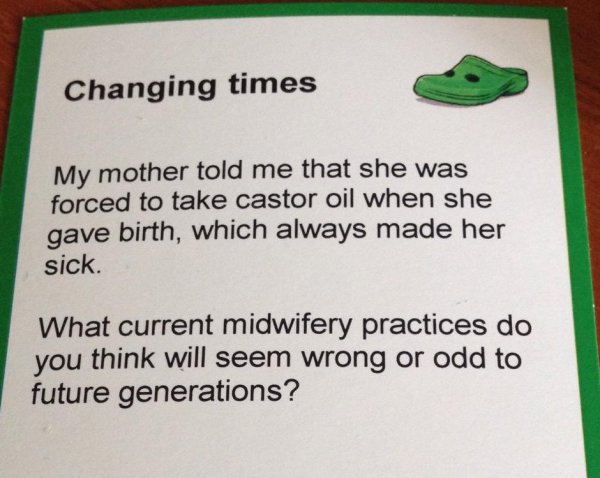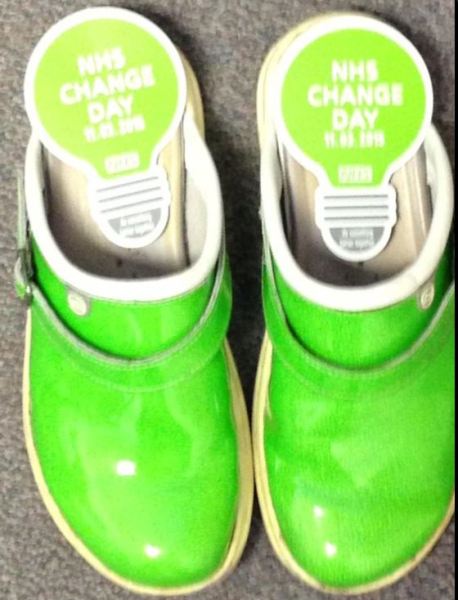#FabObs Florence Wilcock ensured that her roles as obstetrician and mother blurred a bit more (and took many of her colleagues by surprise) when she did something truly wonderful in terms of making people think, really think about the experience of the women they are caring for. She walked in their shoes, which on this occasion involved taking off her shoes…
It is brilliant that Flo has taken the time and trouble to reflect in such detail and share the learning…
Lithotomy is when we put a woman’s legs up in stirrup; sometimes this can be essential for an assisted birth with forceps or ventouse (suction cup) or if stitching is required. But sometimes we use lithotomy position for normal birth or when stitches are minimal.
 In our #MatExp Whose Shoes? workshops, my favourite card is one based on Gill Phillips’ Mum (now aged 93) being made to take castor oil, despite telling the midwife it would make her sick. And it did. The card asks what is common practice now that will similarly seem wrong or odd in the future: the unanimous answer given at Kingston was lithotomy.
In our #MatExp Whose Shoes? workshops, my favourite card is one based on Gill Phillips’ Mum (now aged 93) being made to take castor oil, despite telling the midwife it would make her sick. And it did. The card asks what is common practice now that will similarly seem wrong or odd in the future: the unanimous answer given at Kingston was lithotomy.
I started to think about whether we use lithotomy more than we should and wondered what does it feel like? Although I have two daughters, they were both born by emergency Caesarean so I do not have personal experience of lithotomy although I know some of my midwifery and consultant colleagues already do. It seemed the perfect challenge. I chose to do try it for one hour as that is a quite realistic time that a woman might be in that position, sometimes it can be less, but sometimes it can be far longer.
I decided to wear a hospital gown and some running shorts as it didn’t feel quite right to do it in normal clothes. The first thing I learnt was that the hospital gown was stiff and itchy, I couldn’t get it to do up properly without assistance and when I had finally tied it I sat down to discover it felt as if I was being strangled by the neck line so had to loosen it off immediately. I adjusted the back of the bed but found it quite hard to swivel round & reach the buttons to do so. We put on a fetal heart monitor which just felt like a normal waistband, a blood pressure cuff and stuck an IV line on my arm. We also used a doll to give me a bump. I know not all women will have all these attachments but many will. During this time Tom, who was going to follow me with the challenge, commented that I looked anxious from my body language before I had even begun and it was true I felt quite apprehensive with all these people running around being aware I was about to be totally in their power as it were.
 We were finally ready for ‘legs up’! The first thing I discovered with a slight shock was that the stirrups were very cold which I hadn’t expected at all. The other observation was that the people started adjusting my legs without asking me. I thought one leg was going to fall off as the stirrup wasn’t tightly fixed enough and I was in a slightly twisted position which I asked them to adjust. Once that was done I felt reasonably comfortable and relaxed. They took my blood pressure with an automated cuff which was surprisingly painful. I decided to have a breech baby and we took a few photos.
We were finally ready for ‘legs up’! The first thing I discovered with a slight shock was that the stirrups were very cold which I hadn’t expected at all. The other observation was that the people started adjusting my legs without asking me. I thought one leg was going to fall off as the stirrup wasn’t tightly fixed enough and I was in a slightly twisted position which I asked them to adjust. Once that was done I felt reasonably comfortable and relaxed. They took my blood pressure with an automated cuff which was surprisingly painful. I decided to have a breech baby and we took a few photos.
Twenty five minutes in we decided it was time to take the bottom of the bed off which we would do for an assisted birth. I felt immediately more precariously positioned and vulnerable like I might fall off of the bed. The midwives put my legs higher and the bed much higher off the ground which was the right position for delivery without causing them back problems. This felt quite odd to be high up in the air or as one midwife put it ‘face to vagina’ so that she could see what she was doing at eye level! I definitely could not have got down from there unaided especially not when contracting and in pain. A midwife walked into the room with the door & curtain open and I realised I could see all the way down the corridor which meant everyone in the corridor could potentially see me. Obviously this was a simulation but it did emphasise to me even more the importance of closing the door & curtain behind you to maintain privacy.
A series of people then came to talk to me. Our chief executive Kate Grimes popped in for a chat and asked if I was willing for a film crew to come in to which I agreed. By this point my bottom (sacrum) was getting pretty sore & I had neck ache. I was feeling fairly uncomfortable. My abdomen felt quite compressed and I thought if I was a woman in labour having to push it would probably make me feel quite nauseous.
 In the middle of this Kate Greenstock, our MSLC co-chair arrived. Kate is a doula and came straight to me and asked if I would like a foot massage. Although I thought I was fine, as soon as she asked me I realised actually that I wasn’t fine and here was a person who wasn’t laughing or making a spectacle of me but who actually cared about how I felt. That isn’t to say all the wonderful midwives didn’t but at that moment I felt like Kate and I understood one another and that this was tough and she was ‘on my side’ as it were here to support me.
In the middle of this Kate Greenstock, our MSLC co-chair arrived. Kate is a doula and came straight to me and asked if I would like a foot massage. Although I thought I was fine, as soon as she asked me I realised actually that I wasn’t fine and here was a person who wasn’t laughing or making a spectacle of me but who actually cared about how I felt. That isn’t to say all the wonderful midwives didn’t but at that moment I felt like Kate and I understood one another and that this was tough and she was ‘on my side’ as it were here to support me.
My hour challenge was ticking by and for a short time after the film crew the room emptied out and I was left almost alone. I felt slightly abandoned after such a crowd before and realised if the midwives didn’t come back I was rather stranded in an undignified position. It is not unusual after an assisted delivery for many people to come in and then gradually disappear leaving me as the obstetrician to suture on my own, the midwife popping in and out to get things so in a way this behaviour seemed quite apt.
The midwives returned with a nice plastic baby so that I could have #skintoskin and then my hour was up. The end of the bed was put back in place with the bed rocking as they pushed the parts together and then finally they brought my legs down and it was over.
So what was the impact of me undertaking the lithotomy challenge?
My action has certainly got others thinking and talking. I started tweeting about it in the weeks before change day and challenged a few colleagues. I’m greatly indebted to Professor Jim Thornton who was the first to accept and kicked off a whole week ahead of NHS Change Day.
For us obstetricians there are certainly situations in which lithotomy is invaluable and necessary however this challenge has definitely made me think about the consequences of the length of time and how to keep it to a minimum as the position became much more uncomfortable after half an hour. Sometime in the pressure of work, helpful midwives get women ready for us in position before we enter the room and I had not given much thought to the impact of additional time or someone new entering the room when you are already in this position. The careful use of sheets or drapes to minimise exposure was also a topic for discussion.
In conclusion my hope with my challenge is that in each Trust conversations will happen that change practice and via networks and social media good practice will spread. I hope it will have the ‘butterfly effect’ where one small change in one place will result in large differences later.




[…] by the work of #MatExp on social media, especially #LithotomyChallenge, we decided to focus on women who transfer to theatre with the question; ‘How could we make […]